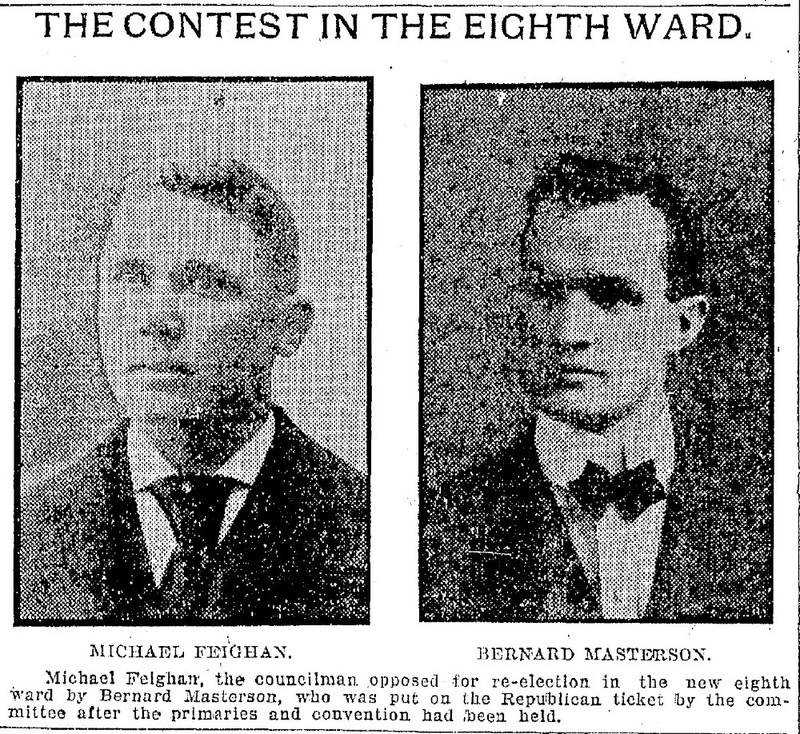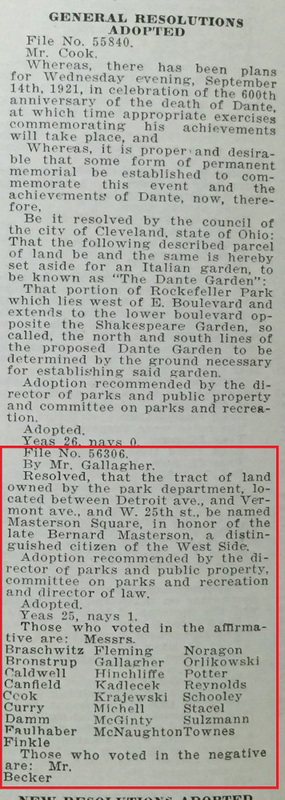
It is one of Cleveland's smallest parks. Not much more than a patch of grass and a lamp post on the northwest corner of West 25th Street and Detroit Avenue. But it is an important public space-- dedicated twice, over the course of the last ninety years, as a memorial to two different legendary Clevelanders--Ward Eight political boss Bernard "Brick" Masterson and famed boxer James Louis "Jimmy" Bivins.
It was, in the first place, road and bridge improvements that created the park — almost as an afterthought. For much of the first two decades of the twentieth century, the city of Cleveland had planned and then constructed Bulkley Boulevard (today, the west Shoreway) and then the Detroit-Superior Bridge, thereby providing more direct access for Clevelanders living on the east side to travel to Edgewater Park on the west side. To address anticipated congestion from traffic coming off the new bridge near West 25th Street, the city purchased, and in 1917 razed, several buildings on Detroit and Vermont Avenues, immediately west of West 25th, using part of the cleared land to create a fan-shaped entrance way onto Bulkley Boulevard. The land that was left over after the fan-shaped entrance way had been created? Well, little thought was apparently given to it until west side Councilman Michael H. Gallagher came along and decided that the remnant land should be a park serving as a memorial to Bernard "Brick" Masterson.
In 1917, Gallagher, a Republican, had been elected Ward Eight Councilman — the ward that then encompassed much of the near west side — defeating three-term incumbent Democrat, William J. Horrigan. Gallagher owed much of his electoral success to Brick Masterson, the Republican ward leader. Masterson, who also was owner of a popular saloon at 1313 West 25th Street, was known on the west side as "Mayor of the Angle." This was perhaps due to his success in turning out the Republican vote in 1909, which contributed significantly to the stunning defeat of Cleveland's most famous mayor, Tom L. Johnson. Nine years after Johnson's defeat, and just four months after he engineered Michael Gallagher's victory over incumbent Councilman Horrigan, the 44-year old Masterson died tragically from a fall he suffered on St. Patrick's Day.
While other politicians likely forgot the colorful ward leader soon after his very public funeral, Councilman Gallagher did not. In 1921, several years after the entrance way to Boulkley Boulevard at West 25th and Detroit had been created, he successfully sponsored legislation to make that small leftover piece of land a park named "Masterson Square." And while some may have poked fun at the little park, as the Plain Dealer did in an article published in 1926, for decades Masterson Square served as a gathering place for community events in the historically Irish Old Angle neighborhood. As late as 1944, it was the site of a gala fundraising event for the new memorial chapel at nearby St. Malachi Catholic Church. And then, apparently, as time passed, and the ethnic composition of the neighborhood changed, the park lost its public identity as a memorial to Brick Masterson.
In the year 2000, eight decades after the park had been first named as the result of one Cleveland councilman's efforts, another Cleveland councilman came along — Ward 14's Nelson Cintron, who decided that it would be a great idea to honor boxing great Jimmy Bivins by naming the park, which was by this time apparently only known to city officials as the "Detroit-West 25th Street park," after him.
James Louis "Jimmy" Bivins, an African American whose family moved from Georgia to Cleveland in 1921 during the Great Migration, was one of the city's best boxers ever, fighting both as a light heavyweight and as a heavyweight. His professional career lasted from 1940 to 1955, during which time he amassed a record of 86-25-1. During the years of World War II, he won the "duration" championship — awarded when Joe Lewis and others were away in the service — in both the light heavyweight and heavyweight classes. Bivins retired from boxing in 1955, but afterwards he became a trainer at the Old Angle Gym, which for many years was located in the Campbell Block, a building catty-corner across the street from Masterson Square. There, Bivins not only trained young men--many of whom came from impoverished areas of the near west side, but he also became a partner in the operation of the gym, contributing his money as well as his time to keeping the gym going, at a time when many Cleveland boxing gym owners were hanging up their gloves for good. After the Campbell Block was torn down in 1975, Bivins moved the gym first to the West Side Community House at West 30th Street and Bridge Avenue, and then in 1978 to St. Malachi School, where he taught boxing to kids there until 1996 when old age and personal tragedy ended his career as a trainer.
On October 4, 2000, Cleveland City Council passed Councilman Cintron's sponsored legislation to name the little park at the corner of West 25th and Detroit Avenue "Jimmy Bivins Park." But no plaque or other signage was ever put up to identify the park. And so it remained for fifteen years until 2015, when a redevelopment proposal came before the City that included the land upon which the park was located. During the redevelopment review process, the City not only learned that the proposal included land that was a city park, but also that the park had been named on two different occasions in honor of two different legendary Clevelanders. City officials are now considering the possibility of upgrading the park, and, hopefully, once and for all, resolving its name.
2021 Update: Apparently, the City has resolved the issue of the twice-named little park by reaffirming that it is Jimmy Bivins Park in honor of the late, great Cleveland boxer. Signage honoring Bivins has gone up in the park area on the northwest corner of Detroit Avenue and West 25th Street.
Images











